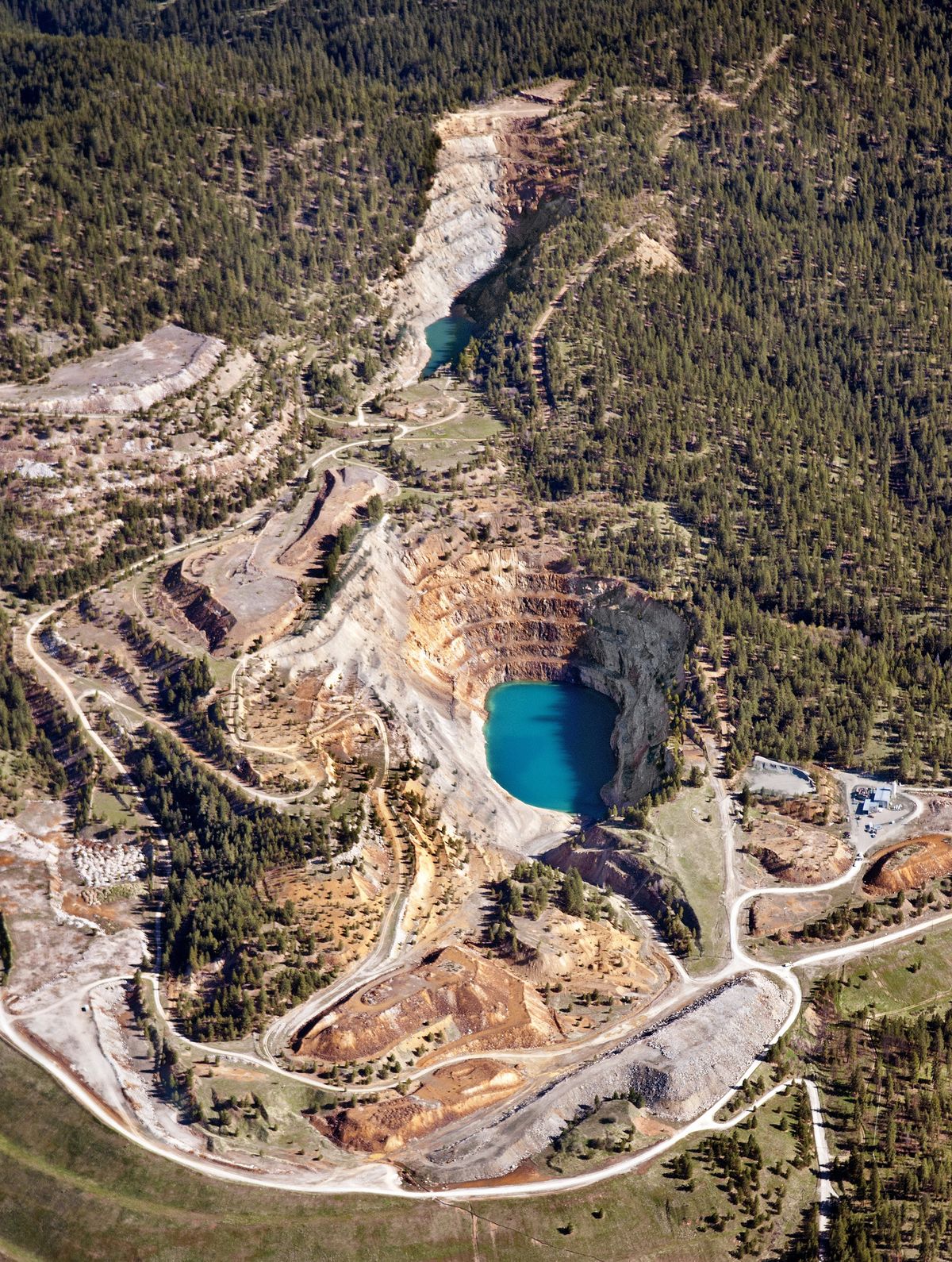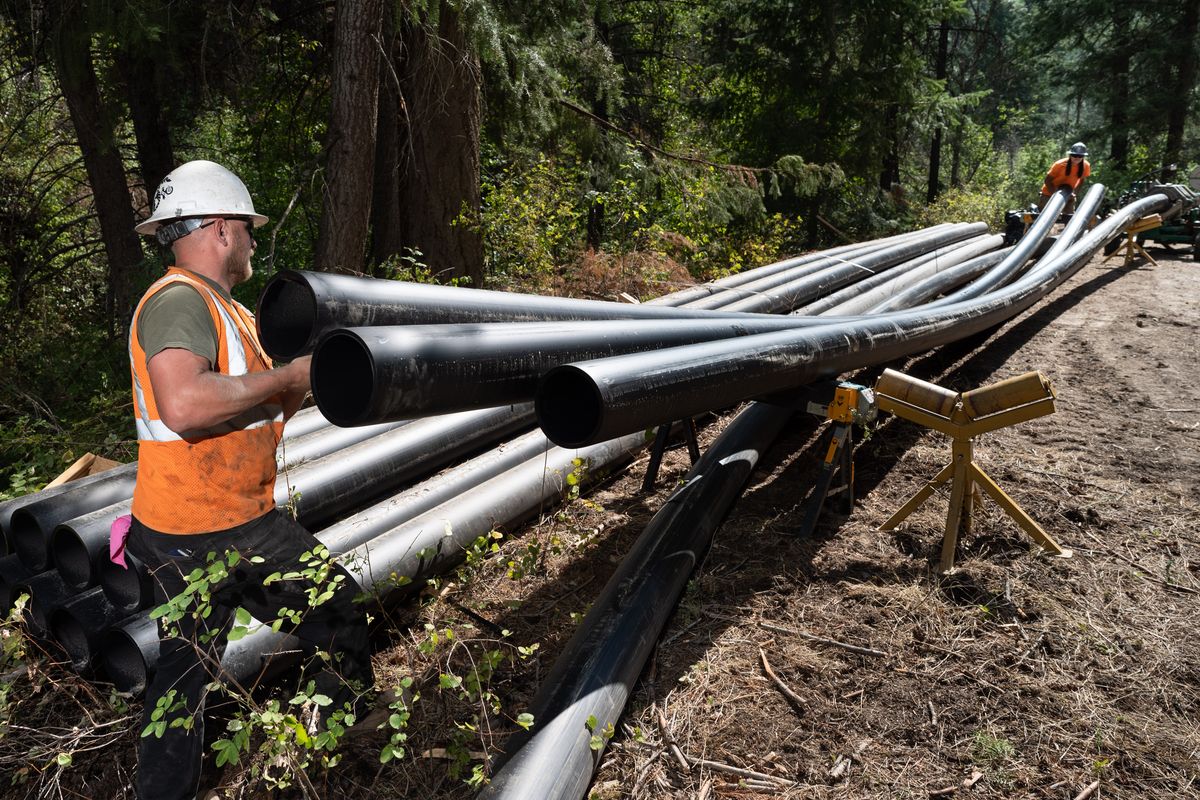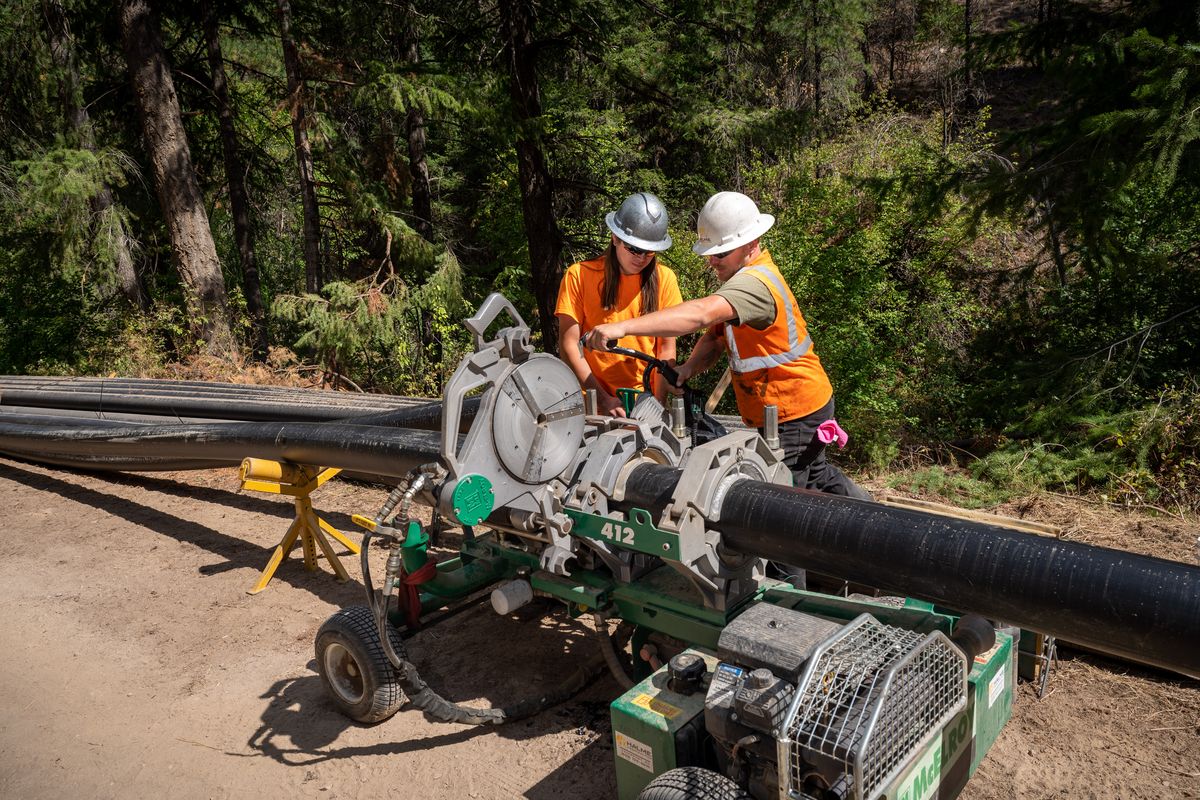New pipeline will deposit treated water from ex-uranium mine directly into Lake Roosevelt
On the Spokane Reservation, Greg Smith, on left and David Abrahamson with Halme Construction, work at laying pipe along Blue Creek, Wednesday, Sept. 1, 2021. Newmont Mining is building a new pipeline that will take treated wastewater from the Midnite uranium mine directly into Lake Roosevelt, instead of letting it drain into Blue Creek. (COLIN MULVANY/THE SPOKESMAN-REVI)
It didn’t look like much, just a snake of black pipe running along the shoulder of a dirt road, above the bank of a small stream called Blue Creek.
But this 8-inch, high-density polyethylene tube will soon become the means of conveying treated but contaminated water from the former Midnite uranium mine on the Spokane Reservation to the depths of the Spokane Arm of Lake Roosevelt, 5.1 miles away.
There, the water will be diffused and diluted far below the surface.
That new system for transporting and releasing the contaminated water will replace the existing system, which involves depositing water from the uranium mine directly into the creek.
The change will mean a significant improvement of the water quality in the creek and will reduce toxic exposure for people and wildlife in the area without causing undue harm to the lake, according to the Environmental Protection Agency, which oversees the mine’s Superfund cleanup, and the Spokane Tribe of Indians, which advocated for the pipeline’s construction.
“Environmentally and to public health concerns, it’s a benefit to run the pipeline and have this solution versus the ways it’s currently discharging,” said Brian Crossley, the Spokane Tribe of Indians’ water and fish program manager and the tribe’s technical lead for the Midnite Mine.
Ricky Sherwood, the Spokane Tribe’s Midnite Mine community liaison, also noted that the water quality standards the tribe has set for the water that enters the pipeline are higher than those of the state and federal government.
“The tribe has the highest water quality standards in the country,” Sherwood said.
Despite such strict standards, the permit that governs the discharge still allows for the water to contain small concentrations of heavy metals and radioactive materials, including arsenic, mercury, zinc and uranium.
And because laboratories can’t detect some of the very low limits, the permit also sets higher “Method Detection Limits” for some contaminants, effectively increasing the lowest amounts that the discharge would have to meet.
That has some observers, like Twa-le Abrahamson-Swan, executive director of the River Warrior Society and an advocate for environmental justice on her tribe’s reservation, concerned the plan will only perpetuate the mine’s legacy of pollution.
“The whole concept is dilution to meet the water quality standards,” Abrahamson said of the $5.1 million pipeline system. “In a cost-saving measure, it’s cheaper for them to build miles of pipeline rather than treat the water accordingly.”
Jerry White Jr., executive director of Spokane Riverkeeper, a nonprofit that aims to preserve the Spokane River’s ecological health, lamented the need for the pipeline, even as he acknowledged it is the “most effective (approach) that we can expect.”
“This is a situation where we really feel like the Spokane tribal water quality team has been working on this situation and has it in hand and has created a plan with the mining company that will go furthest in addressing a tough situation,” White said.
But he still has reservations.
“It always hurts to see discharge into the Spokane River,” White said.
Not that such discharges are new.
Water began flowing from the Midnite Mine with “no controls on releases to surface water” in 1954, the year Dawn Mining Co. began extracting nearly 3 million tons of uranium from an open pit, according to a 2010 report from the federal Agency for Toxic Substances and Disease Registry.
That uncontrolled flow continued until 1978, meaning “all contaminants in run-off and groundwater discharge flowed directly into surface waters,” including Blue Creek and other area drainages for nearly a quarter-century, the report said.
While Dawn Mining began collecting some of the contaminated water at the mine a few years before the mine closed in 1981, it wasn’t until 1988 that the company built a water treatment plant on the site.
Beginning in 1991, water in that plant has been discharged directly into Blue Creek, said Andy Liffring, construction site manager for Newmont Mining Corp.
Newmont, Dawn Mining’s majority owner, is responsible for performing and funding the mine’s Superfund cleanup.
The terms of that cleanup weren’t set until 2006, 35 years after the mine’s closure, when a Record of Decision mandated that Newmont:
- consolidate mine waste at the site primarily into a pair of existing open pits;
- line, cap and cover those pits;
- install dewatering systems to remove groundwater that seeps into the pits;
- treat the water to set cleanup levels;
- construct a new water treatment plant;
- and build a new system to convey the treated water to the Spokane Arm of Lake Roosevelt.
After the decision was issued, Newmont challenged it in court and didn’t begin remediation work for a decade.
The company expects to finish filling the first of the open pits next summer, Liffring said. Meanwhile, crews employed by Newmont are dewatering the other pit and will begin filling it when it’s empty of water.
All told, those two pits will contain 18.3 million cubic yards of mine waste, Liffring said.
Included in that total is the ground underneath the existing, 30-year-old wastewater treatment plant.
Newmont plans to demolish that structure, clean underneath, open the new wastewater treatment plant and, in 2024, connect it to the pipeline being built this summer and finished next spring, Liffring said.
As of mid-last week, a small crew had buried a mile-long section of the pipe and was preparing to send it below the surface of West End Road. Meanwhile, another small crew was welding together sections of the pipe on Blue Creek Road, making their way toward the shore of Lake Roosevelt.
While Liffring expects the pipeline to get close to the water this spring, its route from there to the depths of the center channel of the lake’s Spokane Arm remains under negotiation with the Spokane Tribe.
Liffring said he hopes to have the redesign complete this winter, with a decision expected soon after.
The completed pipeline will have the capacity to handle up to 250 gallons of water per minute, and Newmont is on the hook to treat water from the mine site in perpetuity.
But Liffring said the amount it handles is expected to decline over time.
“The interesting part about this project is that as we continue to do the remediation on the mine site itself, the amount of water that needs to be treated and discharged continues to decrease,” he said.
The water that needs to be treated will be groundwater that seeps into the containment pits and collects beneath the liner. As a result, Liffring said it won’t come into direct contact with the contaminated waste materials.
After being pumped to the surface, it will be sent to the new treatment plant, discharged into the gravity-fed pipeline and diffused into Lake Roosevelt, part of the Columbia River system.
The new method will allow regulators to begin measuring “contamination concentrations in sediments” within the Blue Creek drainage and other drainages “where any of the mine-contaminated water may have run historically and collected in the sediments,” said Linda Meyer, the U.S. Environmental Protection Agency’s project manager for the Midnite Mine Superfund site.
While Meyer said it’s not clear what effect three decades of discharge into the stream has had, ATSDR’s 2010 report warned people against eating fish from Blue Creek or using creek water in sweat lodge ceremonies due to the presence of radioactive materials and heavy metals.
It also cautioned people not to eat deer, elk or moose that forage in the Blue Creek drainage until future studies determine whether the meat is safe.
Crossley, from the tribe, said the pipeline will provide a means of reducing the impact on wildlife, including trout that spawn in Blue Creek, as well as people.
“Your risk to humans and the risk to the biota is less this way,” Crossley said.
White, with Riverkeeper, said he sees those benefits too, even as he lamented the legacy of mining pollution on “marginalized communities and Indigenous communities.”
“I think it’s the best we can get to,” he said. “But in the future we need to be far more careful and far more protective in allowing any new mining operations to occur around water sources and around both groundwater and surface water.”
Abrahamson-Swan, though, said those imperatives are important now, with Blue Creek degraded and the cleanup plan relying, at least initially, on “natural recovery” as a means of remediating contamination.
Contaminated sediments “in the creek are expected to move downstream or be covered by upstream sediments within a reasonable timeframe of approximately 10 years following mine waste containment,” the Record of Decision states.
But if after that time period “significant progress” hasn’t been made, the decision also includes a contingency that could lead to active sediment remediation, according to Mark MacIntyre, a senior public information officer for E.P.A.
“Excavated sediments will be disposed of on site in a manner that does not interfere with the functioning of the remedy and is protective of human health and the environment,” MacIntyre wrote in an email. “EPA is working with Newmont to develop a monitoring plan and triggers for action. It is possible that the contingent remedy would be implemented.”
The lack of a clear plan to monitor and actively remediate the creek, though, concerns Abrahamson-Swan.
“When you really look at the plans, what are they going to do about this area they’ve already contaminated and damaged?” Abrahamson-Swan said. “There aren’t clear answers about how they’re going to handle that.”



